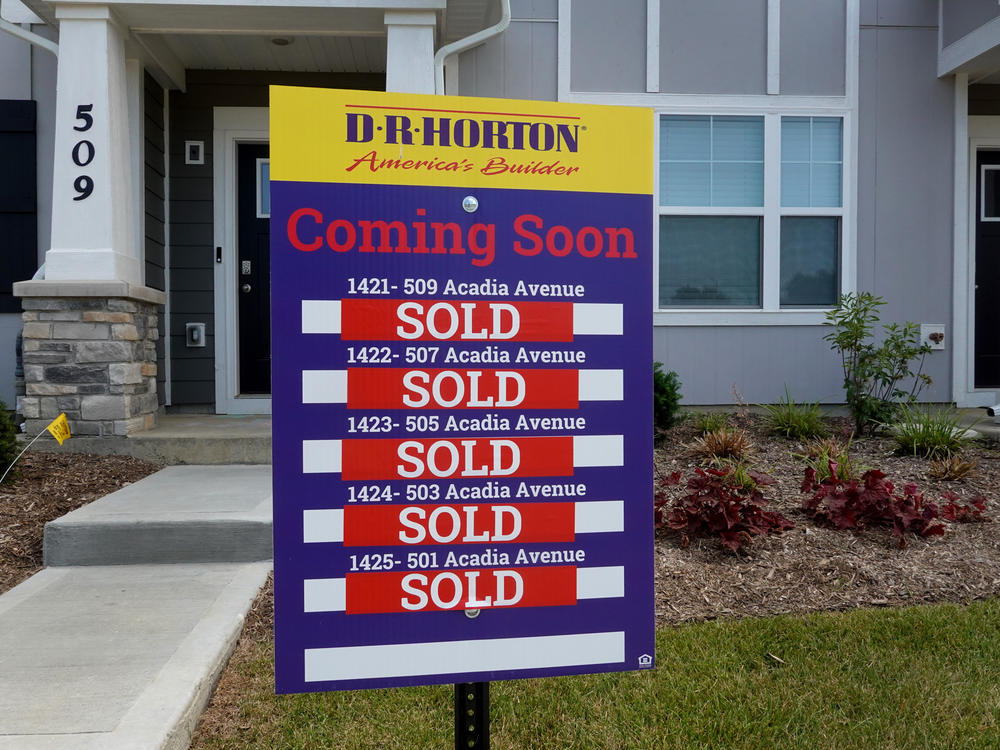Section Branding
Header Content
These are 5 ways surging mortgage rates are reshaping the housing market
Primary Content
Mortgage rates have climbed to the highest level in more than two decades — and that's leading to a split-screen market in housing.
Sales of existing homes have fallen sharply, but new homes are selling fast, as the shortage of "For Sale" signs elsewhere drives more buyers to consider new construction.
Here are five things to know about the unusual housing market.
Some would-be buyers are priced out of the market
The Federal Reserve's aggressive interest rate increases since last year have led to much more expensive mortgages.
That's casting a wet blanket over the housing market. Sales of existing homes in July were down almost 17% from a year ago, according to the National Association of Realtors.
The average interest rate on a 30-year home loan hit 7.23% this week, the mortgage giant Freddie Mac says — the highest since 2001. That means the monthly payment on a $300,000 loan is now about $330 more than it was last summer.
"Because of the interest rate, we have a lot of buyers who are sitting on the sidelines," says Cathy Trevino, chair of the Houston Association of Realtors. "For first-time homebuyers, if they were looking and just kind of waiting this same time last year, they're probably kicking themselves saying, 'I should have bought.'"
Many sellers are sidelined as well
Anyone who bought or refinanced a home in recent years likely has a mortgage with a significantly lower interest rate, so selling would be a costly proposition.
"Many American homeowners just aren't going to move anywhere for a while," says Bankrate analyst Jeff Ostrowski. "They don't want to give up their 3% mortgage, especially if they have to swap it out for a 7% mortgage. That's not great news for people who want to buy. It's constraining the supply of homes."
Indeed, about 15% fewer existing homes were on the market in July than a year ago.
Bidding wars are still common
Fewer existing homes are changing hands these days, but surprisingly, there has been little or no break on prices, and buyers who are in the market are still willing to pay up.
In fact, the average existing home sold in July cost nearly $407,000 — an increase of 1.9% from a year ago. More than a third of homes sold for more than their asking price last month.
"It makes it really challenging for buyers in this marketplace. There's a lot of competition," says Michael Fischer, president of the Atlanta Realtors Association.
He has been working for several months with a family that wants to buy a house, only to wind up in multiple bidding wars.
"Even when you're comfortable with the pricing, when you're actually in the market and you start making offers, you realize there's a lot of other buyers in the same position that you are," Fischer says.
New homes are in high demand
With so few existing homes to choose from, more would-be buyers are turning to new construction.
Sales of new homes in July were up more than 31% from a year ago.
While the average price of a new house rose slightly last month, prices have generally been trending down since the beginning of the year.
A survey by the National Association of Home Builders found about 25% of builders have been cutting prices to bolster sales.
Small is the new big
Builders offering discounts have been helped by falling costs for lumber and other materials, but they've also been designing somewhat smaller houses in an effort to keep prices in check.
That's in contrast to the early days of the COVID-19 pandemic, when buyers were stuck in their houses and demanding as much space as possible.
The average size of a new house has fallen from about 2,350 square feet at the end of 2021 to about 2,200 square feet today, according to the National Association of Home Builders.
Steve Jolly, who led Greater Nashville Realtors last year, has also seen more interest in lower-priced housing options.
"Condos and town homes are becoming more popular," he says. "Not only because of maintenance issues but also because of the price and affordability. And now that they're appreciating at the same rate or even better than single-family homes, that makes it more attractive."
Copyright 2023 NPR. To see more, visit https://www.npr.org.


